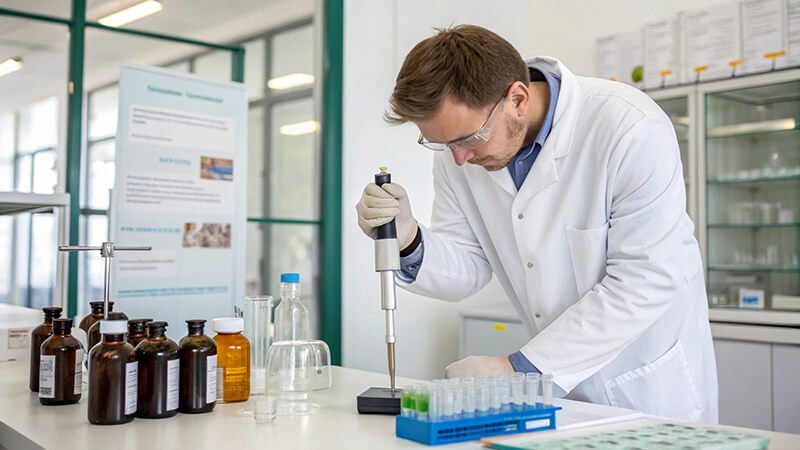Confused about how a fluid's thickness matters in medicine? Ignoring viscosity can lead to misdiagnosis or ineffective treatments. Understanding its role is key.
Viscosity, a measure of a fluid's resistance to flow, has diverse medical applications. It's vital in blood analysis, pharmaceutical development, medical device design, diagnostics, and even specialized nutritional formulas, directly impacting patient care and treatment success.
I've seen in my work at Martests how critical precise fluid properties are. In medicine, this is even more pronounced. Understanding viscosity is not just for lab technicians; it's fundamental to many health outcomes. Let's explore some specific ways viscosity plays a crucial role in the medical field, helping professionals deliver better care.
How Does Blood Viscosity Impact Our Health?
Worried about cardiovascular risks? Blood that's too thick or too thin can signal serious health problems. Proper blood flow is essential for life.
Blood viscosity directly affects circulation and cardiovascular health. Abnormal levels can indicate conditions like polycythemia or anemia, influencing heart strain, oxygen delivery, and the risk of clots or bleeding. Monitoring it is important for diagnosis and treatment.
From my experience, understanding blood rheology – the study of blood flow properties – is fundamental. Blood isn't like water; its viscosity changes with flow rate and vessel diameter.
Key aspects include:
- Hematocrit Levels: The percentage of red blood cells is a primary determinant. Higher hematocrit means higher viscosity. I've seen cases where this directly points to dehydration or more serious conditions.
- Plasma Proteins: Proteins like fibrinogen also contribute significantly to blood's thickness. Inflammation can increase these proteins, raising viscosity.
- Temperature: Lower temperatures increase blood viscosity.
Abnormal blood viscosity can lead to:- Increased workload for the heart.
- Reduced blood flow to vital organs.
- Higher risk of thrombosis (clot formation) if too viscous.
- Potential for bleeding issues if too thin.
Clinicians use blood viscosity measurements to help diagnose and manage a range of conditions, from heart disease to certain cancers. It's a parameter that gives a real insight into a patient's circulatory system.
Why is Viscosity Crucial in Making Medicines?
Ever wonder why some medicines are thick syrups and others thin liquids? The consistency isn't accidental; it's vital for effectiveness and patient use.
Viscosity is critical in pharmaceutical formulation. It affects drug stability, dissolution rate, absorption, patient acceptability (e.g., ease of swallowing syrups, spreadability of creams), and manufacturing processes. Precise control is essential for quality and efficacy.

At Martests, we supply viscometers to companies that understand this principle deeply, including those serving the pharmaceutical sector. For example, Jacky, one of my clients from Italy, often sources lab instruments for pharmaceutical quality control. The viscosity of a liquid medication determines how easily it can be poured, dosed, and administered.
Consider these points:
- Suspensions and Emulsions: Viscosity helps keep active ingredients evenly dispersed in suspensions (like some antibiotics) and stabilizes emulsions (creams and lotions). If the viscosity is too low, particles settle out.
- Controlled Release: For some drugs, higher viscosity is used to slow down the release of the active ingredient, providing a sustained effect.
- Topical Products: The spreadability and feel of creams, ointments, and gels are directly tied to their viscosity. It must be right for effective application and patient comfort.
- Injectables: Viscosity impacts how easily a drug can be drawn into a syringe and injected. Too high, and it's difficult and painful.
Manufacturing processes also rely on correct viscosity for pumping, mixing, and filling. Our viscometers help ensure that each batch meets the precise specifications needed for a safe and effective product.
How Does Viscosity Affect Medical Devices and Implants?
Concerned about the safety and function of medical implants? The fluids they interact with, or contain, have viscosities that can make or break their performance.
Viscosity influences the design and performance of medical devices like catheters, infusion pumps, and artificial joints. It's also key for the biocompatibility and function of lubricants used with implants or devices.

The interaction between medical devices and bodily fluids, or fluids used within devices, is heavily influenced by viscosity. Think about infusion pumps – they must deliver medication at a precise rate, and the viscosity of that medication is a critical parameter for the pump's calibration and accuracy. If the viscosity is off, the dosage could be wrong. For catheters, the ease of insertion and the flow of fluids through them depend on viscosity. In orthopedic implants, like artificial joints, the synovial fluid (or synthetic lubricants used) must have the correct viscosity to provide cushioning and reduce friction. If it's too thin, wear and tear increase. If it's too thick, movement can be restricted. Even the coatings on implants might be selected for how their surface properties interact with fluids of specific viscosities to improve biocompatibility or reduce clotting. It's a complex interplay where viscosity is a central player.
Can Viscosity Be a Sign of Illness?
Are there hidden clues in our body fluids? Changes in the viscosity of fluids like mucus or synovial fluid can be early indicators of disease.
Yes, changes in the viscosity of various bodily fluids can serve as diagnostic indicators. For example, increased synovial fluid viscosity might point to inflammation in joints, while altered mucus viscosity can indicate respiratory issues.

It's fascinating how the thickness of our body's fluids can tell a story about our health. I've learned from medical professionals that these changes are often subtle but significant.
Here are some examples:
- Synovial Fluid: This fluid lubricates our joints. In conditions like osteoarthritis or rheumatoid arthritis, its viscosity can change dramatically. It might become thinner or sometimes thicker due to inflammation or degradation, affecting joint movement and pain.
- Cervical Mucus: Its viscosity changes throughout a woman's menstrual cycle, which is a key indicator for fertility.
- Respiratory Mucus: In conditions like cystic fibrosis or chronic bronchitis, mucus becomes abnormally thick and sticky. This makes it hard to clear from the airways, leading to infections and breathing difficulties. Measuring sputum viscosity can help manage these conditions.
- Saliva: Changes in saliva viscosity can be linked to dehydration or certain autoimmune diseases like Sjögren's syndrome.
These aren't always the first tests ordered, but viscosity measurements can provide valuable supporting evidence for a diagnosis or help monitor treatment effectiveness.
What's Viscosity's Role in Medical Nutrition and Patient Feeding?
Struggling with swallowing difficulties for a patient? The thickness of their food and drink is not just about preference, it's about safety and nutrition.
Viscosity is critical in medical nutrition, especially for patients with dysphagia (swallowing difficulties). Thickened liquids and modified food textures prevent aspiration and ensure safe, adequate hydration and nutrient intake.
This is an area where viscosity directly impacts patient safety and quality of life. For individuals who have difficulty swallowing – perhaps after a stroke, or due to neurological conditions, or even in frail elderly patients – thin liquids like water can easily go down the wrong way into the lungs (aspiration), leading to pneumonia. I've spoken with healthcare providers who rely heavily on precisely thickened liquids. Commercial thickeners are used to achieve specific consistencies, often categorized as nectar-thick, honey-thick, or pudding-thick. Each level corresponds to a certain viscosity range suitable for different degrees of swallowing impairment. Getting this right is crucial. If it's too thin, the risk of aspiration remains. If it's too thick, it can be difficult to swallow and may lead to dehydration or poor intake. Viscosity control ensures that vulnerable patients can eat and drink safely, maintaining their nutritional status.
Why Does Viscosity Matter for Eye Drops and Ophthalmic Solutions?
Do your eye drops disappear too quickly? The right thickness ensures they stay on the eye long enough to work effectively.
Viscosity is key for ophthalmic solutions like eye drops. It influences the drug's contact time with the eye's surface (residence time), absorption, and patient comfort. Too thin, it drains quickly; too thick, it can blur vision.

When it comes to eye drops and other ophthalmic preparations, viscosity is a delicate balancing act. The primary goal is to keep the medication in contact with the eye surface long enough for the active ingredient to be absorbed and do its job. If an eye drop is as thin as water, the blinking reflex and tear drainage will wash it away almost immediately, reducing its effectiveness. That's why many eye drops contain viscosity-enhancing agents like hypromellose or carboxymethylcellulose. These agents increase the solution's thickness slightly, improving its "residence time" on the cornea. However, if the solution is too viscous, it can cause blurred vision, discomfort, or a sticky sensation, which patients won't like. So, formulators must find the optimal viscosity that maximizes therapeutic effect while ensuring patient comfort and compliance. This precision is something we value at Martests when providing instruments for quality control.
Conclusion
In medicine, viscosity is far more than just "thickness." It's a critical parameter influencing diagnostics, treatment efficacy, patient safety, and the performance of medical products.


